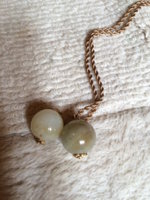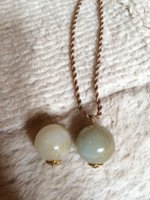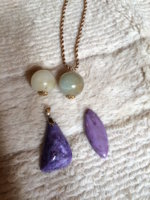Good morning ladies! It's my eldest daughter's birthday party today! So much to do, and Im preparing for teenagers to come over. It's hard to believe that it's been 15 years!
Ixorajade, I can imagine that you are disappointed in not being able to wear such a lovely bangle, but it's wonderful that your eldest loves it! This way, at least you will always get the pleasure of looking at it. It was very generous of you to give it to her.
What a beautiful green one! so, so elegant and soothing to look at. Sorry to read about the condition, and having to take steroids. Wishing you a smooth transition to feeling good and wearing your bangles again!
JKP, those earrings are truly interesting and stunning. I just love the double prongs and the size! I bet one can see them even with your hair down.
Annetok, it can be so hard to get the information about a subject. I find myself having to read from many sources over the years. But, here is a little bit more information about what I said, in order to answer your question, along with a book recommendation:
Regarding the question about ion movement into jade being irreversible:
First, you must understand the diffusion process. You can find this described in any 1st year level text on mineral science. However, the way ions reside in a matrix such as jade amounts to a binding of the ion, hence my use of the word agglomeration. Basically, Lavoisiers principle favors the retention of the ions within the crystal matrix. If you were to heat the jade matrix to just below melting, you *might* be able to observe ions leaving the jade and flowing into some surrounding liquid (not water at this temperature.) Into water, however, this wont happen. The process would be identical to removing color from a sapphire by running it under water. It wont happen because the ions are bound to the crystal lattice.
Abrasion, on the other hand, can easily remove outer layers very rapidly (we cut and polish jade every day.) So, between the two competing processes, ion movement into the jade, creating a colored skin, and removal of this skin by rock tumbling abrasion, the abrasion will always win out in terms of speed.
Another thing to consider is how the B-jadeite is made. VERY strong acid solutions are used at boiling temperatures to actually remove the jade itself along the micro channels where the ion coloration preferentially appears. In other words, the color ONLY departs when the jade itself departs.
As a starting point, you might consider the CRC press book Optical Mineralogy.





